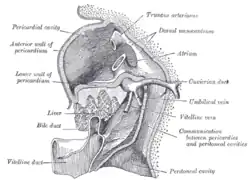Hepatic diverticulum
| Hepatic diverticulum | |
|---|---|
 Liver with the septum transversum. Human embryo 3 mm. long. | |
| Details | |
| Gives rise to | liver |
| Identifiers | |
| Latin | diverticulum hepaticum |
| TE | diverticulum_by_E5.4.6.0.0.0.14 E5.4.6.0.0.0.14 |
| Anatomical terminology | |
The hepatic diverticulum (or liver bud) is a primordial cellular extension of the embryonic foregut endoderm that gives rise to the parenchyma of the liver and the bile duct.[1] It typically differentiates from the endoderm in the third or fourth week of gestation and is reabsorbed in tubular structures of the septum transversum by the eighth week. [2]
References
- ↑ "Hepatic Diverticulum - Medical Definition from MediLexicon". Medilexicon.com. Retrieved 10 July 2018.
- ↑ Meilstrup, Jon W. "Embryology". Structure. WordPress. Retrieved 12 October 2020.
External links
- "Normal Bile Ducts". Meddean.luc.edu. Retrieved 10 July 2018.
- "Developmental Biology". Cincinnatichildrens.org. Retrieved 10 July 2018.
- "Liver, gall bladder and passages; development and function of the liver". Embryology.ch. Retrieved 10 July 2018.
This article is issued from Offline. The text is licensed under Creative Commons - Attribution - Sharealike. Additional terms may apply for the media files.